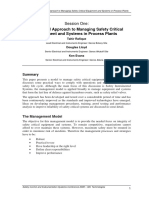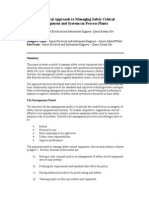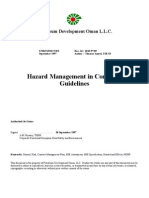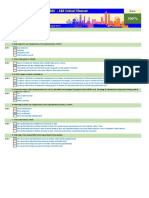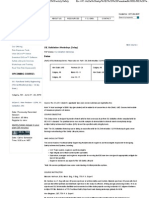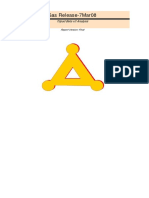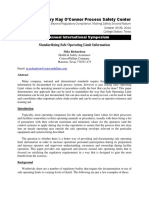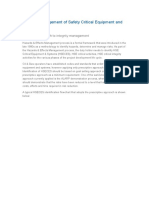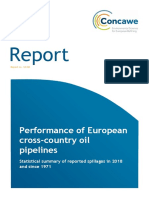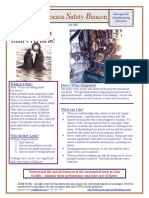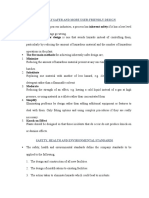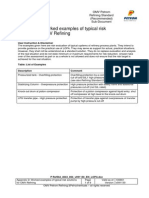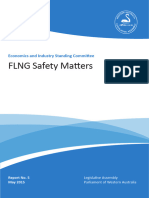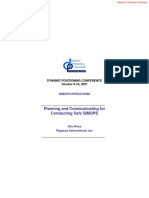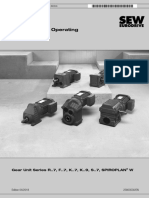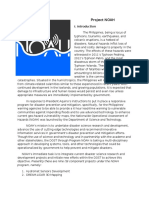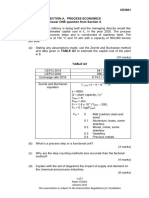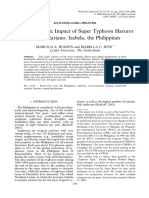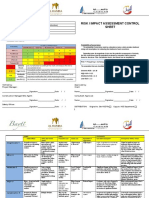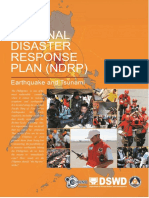AIE | Major Accident Hazards and Identification of SCE Page 1 of 5
10 January, 2018
MAJOR ACCIDENT HAZARDS
AND IDENTIFICATION OF SCE
Major Accident Hazards are defined as any risk events, such as
an explosion or emission of hazardous substance, which could
lead to multiple fatalities of either death or serious injury or cause
damage to connected installations and the stability of the
operating system.
At AIE, we believe that properly engineered and specifically
tailored assurance programs of work will deliver robust and cost-
effective management of Major Accident Hazard risks. AIE’s risk
management process is composed of six discrete steps, which are
as follows:
https://www.assetintegrityengineering.com/major-accident-hazards-identification-sce/ 31/07/2019
�AIE | Major Accident Hazards and Identification of SCE Page 2 of 5
Figure 1: Strategy to manage risks of Major Accident Hazard
Facilities
The strategy begins with the identification of Major Accident
Hazards, Safety Critical Elements and the development of SCE
Performance Standards. The identification and analysis of Major
https://www.assetintegrityengineering.com/major-accident-hazards-identification-sce/ 31/07/2019
�AIE | Major Accident Hazards and Identification of SCE Page 3 of 5
Accident Hazards aid in the identification of Safety Critical
Elements (SCEs) associated with those hazards.
Safety Critical Elements can be defined as such parts where the
failure could cause or contribute substantially to a major accident
or an item with a purpose of which is to prevent or limit the effect
of, a major accident.
The functions that each of the Safety Critical Elements is required
to perform are formally defined in Performance Standards, and
there is one Performance Standard for each Safety Critical
Element. This defines how the element will be required to perform
in order to prevent a major accident or, in the event that a major
accident occurs, how the element will mitigate the effect of a major
accident.
Identification of Safety Critical Components
Safety Critical Components are the constituent parts of Safety
Critical Elements; the identification of Safety Critical Components
is absolutely vital, primarily because the inventory of components
that make up each Safety Critical Element is usually relatively
sizeable (e.g. ‘Hydrocarbon Containment’ is a Safety Critical
Element, however the number of components that this
encompasses is particularly vast, and will likely include the
majority of the pressure systems equipment at each given Major
Accident Hazard facility).
Safety Critical Components can then be individually tagged for the
equipment which form part of each Safety Critical Element and for
which contributes directly to the safety requirements of the
associated Performance Standard. Failure of Safety Critical
Components may serve to prevent the associated Safety Critical
Element from meeting its stated Performance Standard criteria.
Safety Critical Components must be maintained in a fit-for-purpose
condition for safe production operations; it logically follows that
Safety Critical Elements must therefore be cascaded down to
component level in order to be meaningful and properly
representative.
The Challenges
Process plants contain large inventories of equipment; Some
examples of safety critical categorization include:
• Process equipment failures which result in the uncontrolled
loss of process containment could lead to a major accident
event; such equipment would logically be categorized as
safety critical.
• An actuated valve that fails to open or close could initiate a
series of events that eventually causes a major accident and
could therefore also be categorized as safety critical.
https://www.assetintegrityengineering.com/major-accident-hazards-identification-sce/ 31/07/2019
�AIE | Major Accident Hazards and Identification of SCE Page 4 of 5
• Pressure relief valves provide over-pressure protection and
thereby would be deemed to be safety critical.
• Sensors designed to detect process upsets, the failure of
which could lead to a major accident, may be considered
safety critical.
The inventory of Safety Critical Components throughout operating
plants can be significant if the assessment is not performed with
the correct focus, skill and experience. The primary challenge is
deciding whether a component item is truly critical to safety and
thereafter how the relative importance of the identified Safety
Critical Component is then prioritized for on-going maintenance.
The Solution
In AIE, we proactively work in support of our clients in the
management of Major Accident Hazard risks; our processes and
procedures serve to facilitate the accurate and robust identification
of the process plant and equipment that is the most critical to
safety.
We have shown repeatedly that some plant safeguards do not
actually significantly reduce risk, and therefore are not critical to
safe operations when compared with those that provide order-of-
magnitude risk reductions. Our processes serve to limit the
inventory of Safety Critical Components to only those which are
truly critical to safety.
We do not advocate an ‘include it all’ approach to the
categorization process as this would lead to a substantially larger
than necessary inventory of Safety Critical Components that would
place unnecessary resource demands to inspect, test and
maintain. We, however, advocate proper identification of the
critical components to safety, this approach is efficient as only the
necessary components are regularly inspected, tested and
maintained.
AIE focusses its efforts on providing our clients with an enhanced
understanding of safety criticality across their facilities; this allows
the requisite focus on the proactive management of Safety Critical
Components thereby optimizing the process and maximizing its
effectiveness.
Maintenance is very clearly an integral part of the process by
virtue that failure of Safety Critical Components may likely
compromise the associated Safety Critical Element. Safety
Critical Components are therefore required to be captured within
the Computerised Maintenance Management System with
appropriately defined and scoped Planned Maintenance Routines
(PMR). This serves to provide the requisite level of assurance that
the Safety Critical Components will meet their required
functionalities, thereby ensuring that each associated Safety
Critical Element will continue to meet its stated Performance
Standard criteria.
https://www.assetintegrityengineering.com/major-accident-hazards-identification-sce/ 31/07/2019
�AIE | Major Accident Hazards and Identification of SCE Page 5 of 5
AIE offers the full suite of services; we can provide the necessary
support and assistance for all steps in the process (per Figure 1)
from the identification of Major Accident Hazards, right through to
defining the requisite Planned Maintenance Routines (including
the population of these within the Computerized Maintenance
Management System) and conducting Performance
Assessments. Within AIE, we tailor our services to suit our clients’
needs and requirements.
Benefits
AIE possesses the requisite knowledge, experience and track
record in this specialised area of operations; we believe that
engagement of our services will add value and deliver the
following benefits:
• Robust identification of inventories of Safety Critical
Components and the specification of the requisite measures
to assure functional reliability whilst in-service.
• Assurance of the functional reliability of Safety Critical
Elements, thereby maximising safety performance and the
effectiveness of the measures being deployed in the
management of Major Accident Hazard risks.
• Provision of robust services that are specifically tailored to
the needs of our clients.
• Execution of services by an organisation that is strongly
focussed on quality, delivery and client satisfaction.
If you would like to know more about our consultancy services and how
our team can support your requirements, please visit our contact us
page and we will promptly respond to your inquiry.
https://www.assetintegrityengineering.com/major-accident-hazards-identification-sce/ 31/07/2019


